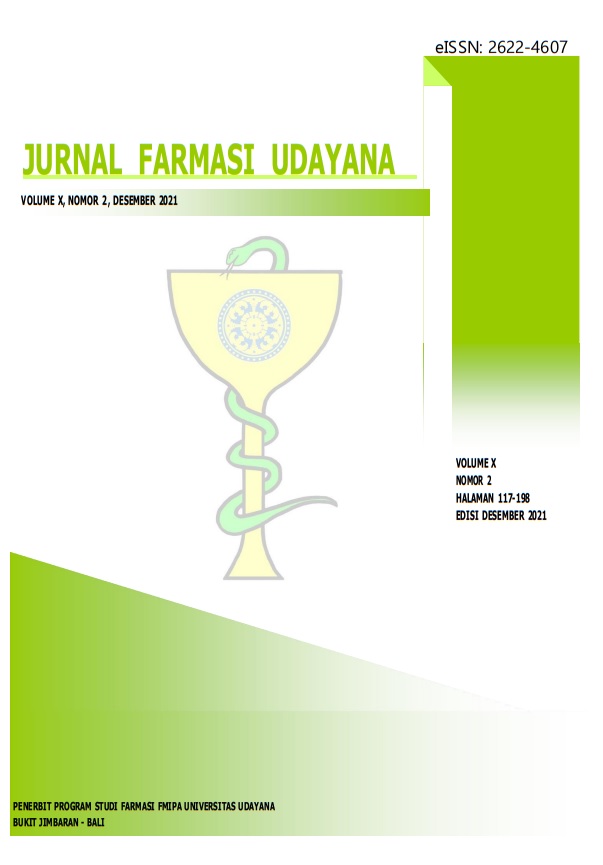Korelasi Tingkat Kepatuhan Konsumsi Obat Antiepilepsi Menggunakan Kuesioner MGLS (Morisky, Green, Levine Adherence Scale) dengan Frekwensi Kejang Pasien Epilepsi
Abstract
Epilepsi merupakan penyakit gangguan kronis pada otak yang tidak menular yang dapat mempengaruhi orang dari segala usia. OAE (obat antiepilepsi) merupakan terapi utama kebanyakan pasien epilepsi dengan tujuan keseluruhan adalah secara menyeluruh untuk mencegah terjadinya kejang tanpa menyebabkan efek samping. Salah satu ukuran manajemen terapi obat pada penyakit epilepsi adalah menurunnya/hilangnya kejang, sehingga frekwensi kejang menjadi salah satu ukuran pencapaian end outcome. Penelitian ini merupakan penelitian observasional cross sectional yang dilakukan pada pasien epilepsi rawat jalan poli syaraf Rumah Sakit Universitas Airlangga, yang bertujuan untuk melihat hubungan antara tingkat kepatuhan menggunakan obat antiepilepsi dengan kejadian kejang pada pasien epilepsi. Tingkat kepatuhan konsumsi OAE pada penelitian ini menggunakan kuesioner MGLS (Morisky, Green, Levine adherence Scale). Tingkat kepatuhan berdasarkan kuesioner MGLS dibagi menjadi 3 tingkatan diantaranya patuh rendah, menengah atau sedang dan patuh tinggi. Kejadian kejang pada pasien epilepsi yang diamati adalah ada atau tidaknya kejang selama sebulan terakhir, yang datanya diperoleh dari wawancara pasien atau keluarganya serta dari diary seizure. Hasil penelitian dari 40 responden diketahui terdapat korelasi positif sedang antara tingkat kepatuhan yang diukur menggunakan kuesioner MGLS yang mayoritas patuh sedang dengan adanya kejadian kejang pada pasien epilepsi (r = 0,423 dengan nilai p = 0,006 <0,05).
Downloads
References
2. J.P. Leach, R.J. Davenport, Neurological Disease. In : Walker, B.R., Colledge, N.R., Ralston, S.H., Penman, I.D. (Eds). Davidson’s Principles and Practice of Medicine 22 th ed. London : Churchill Livingstone Elsevier. 2014. p1137-2230
3. M. Aminoff, V. Douglas, Nervous System Disorders. In : Papadakis, M. A., McPhee, S. J., Rabow, M. W. (Eds). Current Medical Diagnosis & Treatment 56th ed. New York : McGraw Hill Education. 2017. p 983-990
4. WHO. World Health Organization Fact Sheet: Epilepsi, updated February. 2017. Available from: http://www.who.int/en/news-room/fact-sheets/detail/epilepsy
5. Widyati, Soediatmoko, Z. Ikawati, L. Hakim, “Dampak Positif Pelayanan Farmasi Klinik Pada Pasien Epilepsi”. Jurnal Manajemen dan Pelayanan Farmasi, p217-222. 2013
6. I.E. Leppik. Compliance in the treatment of epilepsi. In: The treatment of epilepsi. 2nd ed. Willie E, editor. Williams and Wilkins. 1997. p779-784
7. M. Rasheva, I. Staikov, D. Svinarov, N. Mihnev, N. Neykov, M. Staneva, Low “Serum Levels of Antiepileptic Drugs in Patients with Epilepsy-Bad Compliance or Something Else?”. Austin J Clin Neurol; vol 2, no 10, p1083. 2015
8. S. Al aqeel, J. Al-sabhan, M. Hiligsmann. “Strategies for improving adherence to antiepileptic drug treatment in people withepilepsy”. Cochrane Database of Systematic Reviews. 2. 2017
9. C.A. Hovinga, M. R. Asato, R. Manjunath, J.W. Wheles, S.J. Phelps, R.D. Sheth. “Association of non-adherence to antiepileptic drugs and seizures, quality of life, and productivity: Survey of patients with epilepsy and physicians”. Epilepsy Behav, vol 13 no 2, p316–322. 2008
10. D.E. Morisky, L.W. Green, D.M. Levine, Concurrent and predictive validity of a self-reported measure of medication adherence. Med Care; vol. 24, p67–74. 1986
11. H. Beyhaghi, B. B. Reeve, J. E. Rodgers, S. C. Stearns, “Psychometric Properties of the Four-Item Morisky Green Levine Medication Adherence Scale among Atherosclerosis Risk in Communities Study (ARIC) Participants”. Value Health, vol. 19, no. 8, p996–1001. 2016
12. A. M. Al qarni, T. Al rahbeni, A. Al qarni, H. M. Al qarni, “Adherence to diabetes medication among diabetic patients in the Bisha governorate of Saudi Arabia – a cross-sectional survey”, Patient Preference and Adherence, vol. 13 63–71. 2019
13. I. Ernawati, W.I. Islamiyah. “Uji Validitas Dan Reliabilitas Kuesioner Kepatuhan MGLS (Morisky, Green, Levine adherence Scale) Versi Bahasa Indonesia Terhadap Pasien Epilepsi”. Jurnal Ilmiah Ibnu Sina, vol. 4, no. 2, p305-313, 2019
14. W.M. Gabr, M. Shams, “Adherence to medication among outpatient adolescents with epilepsy”. Saudi Pharmaceutical Journal, vol. 23, p33–40. 2015
15. R. Manjunath, K.L. Davis, S. D. Candrilli, A. B. Ettinger, “Association of antiepileptic drug nonadherence with risk of seizure in adults with epilepsy”. Epilepsy Behaviour, vol 14, p372-378. 2009
16. C.M. Ferrari, R.M. De Sousa, L.H. Castro. “Factors associated with treatment non-adherence in patients with epilepsy in Brazil”. Seizure. vol. 22, p384–389. 2013
17. R.M. Jones, J.A. Butler, V.A. Thomas, R.C. Peveler, M. Prevett, “Adherence to treatment in patients with epilepsy: association with seizure control illness beliefs”. Seizure. vol. 15, p504-8. 2006
18. A.J. Shallcross, A.B. Becker, A. Singh, D. Friendman, R. Jurd, J.A. French et al. “Psychosocial Factors Associated With Medication Adherence In Ethically And Socioeconomically Diverse Patients With Epilepsy.” Epilepsy Behav. Vol. 46, p242–245. 2015
19. WHO. Adherence to long-term therapies: evidence for action . Diakses bulan Maret 2020. Diakses pada https://www.who.int/chp/knowledge/publications/adherence_report/en/
20. E. Sabaté. Adherence to long-term therapies: evidence for action. World Health Organization. 2003
21. D.Dash, T.M. Sebastian, M. Aggarwal, M. Tripathi. Impact of health education on drug adherence and self-care in people with epilepsy with low education. Epilepsy & Behavior. Vol. 44, p213–17. 2015
22. C.E. Elger, D. Schmidt. “Modern management of epilepsy: a practical approach”. Epilepsy Behav; vol. 12, p501-39. 2008
23. G. O’Rourke, J.J. O’ Brien, J.J, “Review. Identifying the barriers to antiepileptic drug adherence among adults with epilepsy”. Seizure. 45. 2017
24. Ernawati, I., Islamiyah, W.R., Sumarno. “How To Improve Clinical Outcome of Epileptic Seizure Control Based on medication Adherence? A Literature Review”. Open Access Macedonian Journal of Medical Sciences. vol. 6, no. 6, p1174-1179. 2018
25. W. R. Islamiyah, Suharjono, H. P. Jaya, I. Ernawati, “Analysis Relationship of Self-Medication Card Administration with Adherence (ARMS Score), Phenytoin Serum Levels and Frequency of Seizures in Patients using Phenytoin Monotherapy”. Research Journal Of Pharmacy and Technology. Vol. 12, no.12, 2019
26. A.M. Paschal, S.R. Hawley, T.S. Romain, E. Ablah. “Measures of adherence to epilepsy treatment: Review of present practices and recommendations for future directions”. Epilepsia, 49(7):1115–22. 2008
27. J.D. Desai. “Epilepsy And Cognition”. J Pediatr Neurosci, 3, 1627. 2008
28. M.J. Connor. Epilepsy: Nature, Management, And Memory. Epilepsia, 24, 1827. 1994
29. G.A. Baker, A.J Hothersal, J.E Mallow. “Memory”. Epilepsy Action, vol. 10, p16. 2008




